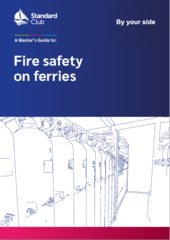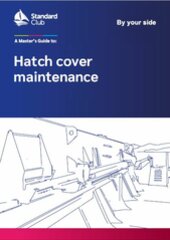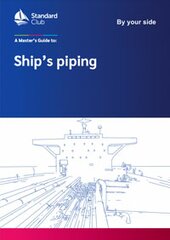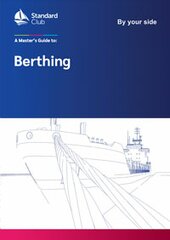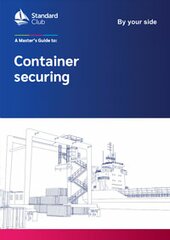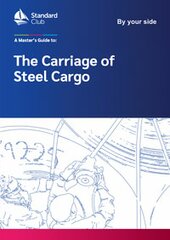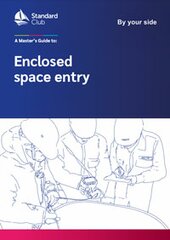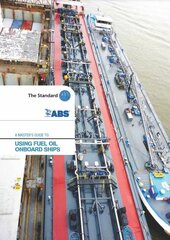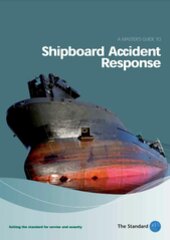Our new NorthStandard site is now live. There will be no new content or updates added to this site. For the latest information, please visit our new site north-standard.com.
Master’s Guides
Our loss prevention team has written and published a unique series of Master’s Guides. Each one focuses on how to achieve best practice in key areas of shipboard operations.
The guides were created by harnessing the professional knowledge of the former seafaring members of our loss prevention team, combined with input from relevant industry experts.
The aim of the guides is to provide practical and technical advice that will serve to eliminate claims deriving from common errors and mistakes during routine shipboard operations.
Free to download
The guides make excellent training manuals and are free to download and use:
A Master's Guide to Fire Safety on Ferries, 2021
The purpose of this guide is to promote best practice in fire safety, and to raise awareness of fire risks in general and fire risk on ferries in particular.
View more information
1 Introduction
2 Basic advice
3 Basic fire science
4 Fire safety and ferry construction
5 Firefighting equipment and its use
6 Emergency preparedness
7 The human element
8 Accident investigation
9 Dos and don’ts checklist
10 Appendix 1: Case studies
11 Appendix 2: SOLAS chapter II-2, fire safety 36requirements on ship construction – fire protection, detection and extinction
12 Appendix 3: IMO Circulars
A Master's Guide to Hatch Cover Maintenance, 2021
The purpose of this guide is to explain the key issues of hatch cover security and to steer mariners towards active maintenance. Ensuring hatch covers are well maintained reduces the number and cost of cargo wet damage claims.
View more information
1 Introduction
2 Hatch covers and their function
3 Types of hatch covers
4 Basic advice
5 Common false beliefs about hatch covers
6 Leakage problems
7 Use of sealing tape and foam fillers
8 Leak detection tests
9 Monitoring and inspection
10 Maintenance and repair
11 Heavy weather precautions
12 Safety when working with hatch covers
13 Appendix 1 – Procedures to open and close hatch covers
14 Appendix 2 – Hatch cover inspection checklist
15 Appendix 3 – Hatch cover operation checklist
16 Appendix 4 – Sample form for ultrasonic weathertightness test of hatch covers
A Master's Guide to Ship's Piping, 2021
Everyone knows about the effect of corrosion on a ship’s hull, but few people consider the effect of corrosion on piping. Pipes pose a hidden danger, a danger that is often neglected.
View more information
1 Introduction
2 Pipes and P&I claims
3 Basic information
4 Pipes and ship classification societies
5 Ships’ piping systems
6 Pipe design
7 Causes of pipe failure
8 Dealing with pipe failure
9 Pipe maintenance
10 Pipe repair
11 Dos and don’ts
12 Appendix I – Mechanical joints in common use
13 Appendix II – Pressure test procedure
A Master's Guide to Berthing, 2021
This is the third edition of Standard Club’s guide to berthing, which was first produced in 2004. This new version includes further content on berthing aids, snap-back zones and bow thrusters. The guide also provides guidance on electronic berthing aids and detailed tug assistance.
View more information
1 Golden rules of berthing
2 Ship factors that affect manoeuvring
3 Berthing in wind
4 Effect of current
5 Hydrodynamic effects
6 Berthing without tugs
7 Berthing with tugs
8 Berthing with anchors
9 Electronic berthing aids
10 Thrusters
11 Mooring stations forward and aft
12 Snap-back zones
13 Fenders
14 Tugs and pilots – legal issues
15 Master/pilot relationship (incorporating the ICF/Intertanko/OCIMF Guide)
16 Standard references
A Master's Guide to Container Securing, 2020
The purpose of this guide is to discuss container securing systems, the causes of lashing failure and to offer advice on how losses can be minimised.
View more information
1 Introduction
2 Basic advice
3 Dos and don’ts
4 Lashing systems – common false beliefs
5 Safe working
6 Ships
7 Containers
8 Container construction
9 Lashing components
10 Principles of stowage
11 Ship behaviour
12 Consequences of failure – case study
鋼材貨物の輸送
本書は、2009年に発行された鋼材貨物の輸送に関するスタン ダードクラブのガイドの第三版です。本新版では、積付、重量 分散およびCalifornia Block Stowageの原理に関する追加の 助言を掲載しています。本ガイドは、ベストプラクティスの推進 と鋼材貨物の輸送におけるリスクの啓発を目指すものです。 船長、貨物担当航海士、陸上の業務スタッフ向け参考ガイドと して執筆されました。
View more information
1 Steel manufacture
2 Basic advice
3 Steel commonly shipped by sea
4 Steel cargo surveys
5 Bills of lading
6 Steel coils and ship’s strength
7 Principles of stowage
8 Principles of securing
9 Cargo officer’s duties during steel cargo loading/discharge
10 Ship husbandry and steel cargo
11 Safety when working with steel
12 Appendix: Case study 1 – Damaged cargo and clean bills of lading
13 Appendix: Case study 2 – Poor dunnage
14 Loading checklist
15 Conclusion
Available in:
A Master's Guide to Enclosed Space Entry, 2020
The purpose of this guide is to assist seafarers to enter enclosed spaces safely, in order to prevent enclosed space-related casualties.
View more information
1 Example incidents
2 What is an enclosed space?
3 IMO/SOLAS regulations
4 Safety Management Systems (SMS)
5 Enclosed space hazards
6 Risk assessment
7 Entry procedures
8 Additional precautions where the atmosphere is known or suspected to be unsafe
9 Hazards relating to ship types and cargo
10 Managing shoreside personnel
11 Training, drills, and rescue
12 Appropriate equipment
13 Conclusion
A Master's Guide to Using Fuel Oil Onboard Ships
The purpose of this guide is to provide masters, ships’ officers and shore superintendents with a basic knowledge of the use of, and precautions to be taken when using fuel oils onboard ship.
View more information
1 Introduction
2 Fuel oil and insurance claims
3 Bunkering
4 Documentation
5 Storage
6 Processing
7 Machinery using fuel oil
8 Additional precautions
9 Regulations and standards
10 Glossary
A Master's Guide to Shipboard Accident Response
The purpose of this guide is to list, in simple terms, the actions that Masters should take when there is an incident or problem that may result in claims against the shipowner or manager.
View more information
1 Introduction
2 Basic Advice
3 Avoiding Accidents
4 Collection of Evidence
5 Death or Injury
6 Bills of Lading
7 Collisions and Property Damage
8 Pollution
9 Cargo Loss or Damage
10 Stowaways and Ship Security
11 Salvage and General Average
12 And Remember

